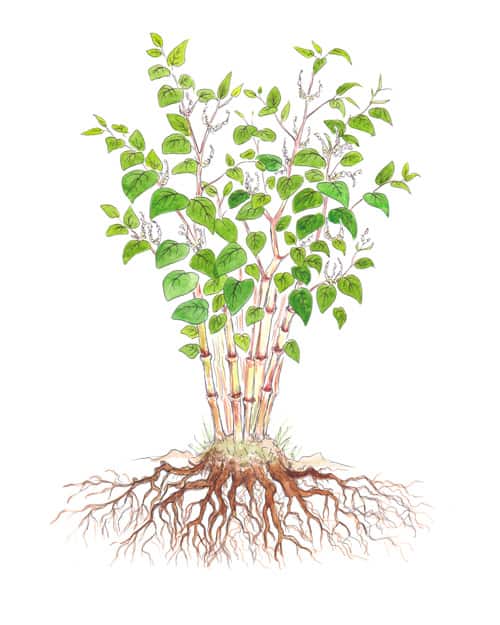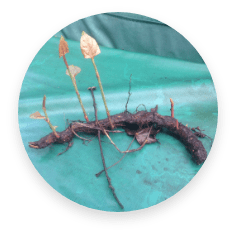Everything You Need To Know About Japanese Knotweed
What is Japanese Knotweed?

How did Japanese Knotweed get to the UK?
The plant was introduced to the UK in the early 1800s by German botanist Philipp Franz von Siebold, who discovered it near a volcano and thought it would make an attractive addition to residential gardens. In 1854, he sent samples to the Royal Botanic Gardens, and from there, it was distributed to other gardens, including those in Edinburgh.
Initially celebrated for its ornamental qualities, Japanese knotweed thrived in the British climate and quickly spread from gardens to the wild. The first wild sighting in the UK was recorded in Maesteg, South Wales, in 1886. By the 1960s, it was even used to stabilise loose soil in Welsh coal-mining valleys.
Recognising its invasive nature, the UK government declared Japanese knotweed a pest species under the Wildlife and Countryside Act of 1981. This legislation makes it illegal to allow the plant to grow in the wild, and property owners must control its spread or face fines.
What is Japanese Knotweed? – A brief history
Resolving an issue is so much easier when you get to the root of the problem. And given the roots are the main obstacle of Japanese Knotweed dangers, let’s start by looking at exactly what Japanese knotweed is and why it’s problematic.

Japanese knotweed in the UK dates back to 1850 when a German-born botanist, Philipp Franz Balthasar von Siebold, brought it over to Victorian Britain.

Over a period of many decades the plant was sold by a large number of nurseries and gardeners with cuttings being distributed into gardens nationwide.

Japanese knotweed was added to the invasive species list and controlled under the Wildlife and Countryside Act 1981.

Legislation was updated to limit the spread and distribution of the species. This legislation requires transportation of Japanese knotweed to be completed by a registered waste carrier.




Japanese knotweed in the UK dates back to 1850 when a German-born botanist, Philipp Franz Balthasar von Siebold, brought it over to Victorian Britain.
Over a period of many decades the plant was sold by a large number of nurseries and gardeners with cuttings being distributed into gardens nationwide.
Japanese knotweed was added to the invasive species list and controlled under the Wildlife and Countryside Act 1981.
Legislation was updated to limit the spread and distribution of the species. This legislation requires transportation of Japanese knotweed to be completed by a registered waste carrier.
Why is Japanese knotweed a Problem?
Japanese Knotweed’s rapid growth and strong root system can damage buildings, roads, and other structures. It outcompetes native plants, leading to a loss of biodiversity and disruption of local ecosystems.
View our new infographic for all you need to know about dealing with Japanese Knotweed.
10 - year Insurance Backed Guarantee
We offer our 10 Year Insurance Backed Guarantee (10 Year IBG) following treatment and removal. This guarantee will cover your property against the regrowth of Japanese knotweed after removal.
How do I get rid of Japanese knotweed?
If left untreated, Japanese Knotweed quickly exploits weaknesses in brick, tarmac, and metal piping, causing costly damage to everything. All of our treatment plans are tailor-made to suit each individual case.
What does Japanese Knotweed look like?
Reddish-purple shoots emerge from crimson-pink buds at ground level, quickly growing. The heart- or shovel-shaped leaves, grow in an alternate zig-zag pattern along the stems.
Japanese Knotweed characteristics
Japanese Knotweed can easily be confused with other, similar plants at first glance. Knotweed is very distinctive at each stage of its growth cycle:
- Spring: In early spring, red or purple shoots appear and grow into canes which sprout leaves that later unfurl and turn green.
- Summer: Japanese knotweed is fully grown in the summer, the canes are matured and hollow and hold a distinctive purple speckle. They can grow up to three to four metres high. In late summer the Japanese knotweed flowers create clusters of small creamy-white flowers.
- Autumn/Winter: Leaves turn yellow and fall off, revealing the bamboo-like stems.
Japanese knotweed roots or rhizomes are the extensive underground part of the plant. The rhizome is bright orange or yellow. The nodes are usually spaced approximately one or two centimetres apart
Japanese Knotweed Images
How does Japanese Knotweed spread?
The problem with Japanese knotweed is that it can sprout from as little as 2mm of rhizome, meaning it is classed as “controlled waste” under the Environmental Protection Act of 1990 and must only be disposed of into licensed landfill sites to stop further spread. Any attempts to remove knotweed should therefore be carried out by licensed professionals. If any small portion of the plant is left in the soil, even a few inches, it can very quickly re-sprout. Only killing the entire underground root system will guarantee the removal of the plant.
Japanese Knotweed damage
Japanese knotweed damage can be extensive. knotweed’s strong, robust plant structure means it can thrive in a wide range of growing conditions. Soil pH or salinity has little impact on the growing rate of the plant, and it can survive temperatures as low as -35°C. This is how it is able to exploit gaps in concrete and brick, taking root and causing structural damage to driveways, roads, and property foundations.
This can seriously affect the value of your home and influence your chances of getting a mortgage accepted.
Its ability to grow up to 10cm a day during the summer means it can quickly and easily overwhelm competitor plants and threaten properties by taking root within foundations. Japanese knotweed root systems grow extensively, up to three metres deep and up to seven metres in all other directions. This makes removing the roots a difficult and labour-intensive task.
What Does the UK Law Say About Japanese Knotweed
The UK has several laws that address the handling, control, and disposal of Japanese Knotweed. These include:
- Wildlife and Countryside Act 1981: Section 14(2) makes it an offence to plant or cause Japanese Knotweed to grow in the wild. A conviction can lead to a fine or imprisonment.
- Environmental Protection Act 1990: This Act regulates the disposal of Japanese Knotweed as controlled waste. It is illegal to keep, treat, or dispose of such waste in a manner likely to cause environmental pollution or harm to human health.
- Environmental Protection (Duty of Care) Regulations 1991: These regulations outline the responsibilities for handling and transferring waste, ensuring it is managed safely and legally.
- Anti-social Behaviour, Crime and Policing Act 2014: Allows for Community Protection Notices to be issued to landowners requiring them to control or prevent the growth of Japanese Knotweed if it causes problems to communities.
Is it illegal to have Japanese Knotweed on my land?
It is not illegal to have Japanese knotweed growing on your land, however it is illegal to allow Japanese knotweed to spread to a neighbouring property or adjoining land.
Individuals with Japanese knotweed on their premises have a legal responsibility to prevent the spread of the weed into neighbouring locations.
Knotweed Encroachment Issues
Failure to stop the spread of Japanese knotweed to neighbouring properties is an offence that can result in an Antisocial Behaviour Order (ASBO) and a fine of up to £2,500.
If there is Japanese knotweed in your neighbours garden or knotweed growth on adjoining land, you should speak directly with your neighbours or the landowners, as they could already be taking steps to prevent Japanese knotweed spread. In the event of the homeowner or landowner failing to act, you can contact you local council.
Knotweed Control Industry Legislation
Various regulations exist to manage the control and disposal of Japanese Knotweed. These include:
Knotweed Waste Disposal Regulations
Waste containing Japanese Knotweed is classified as controlled waste. It must be handled and disposed of in accordance with the Environmental Protection Act 1990 and relevant waste management regulations. Disposal should be carried out at licensed landfill sites, and transportation must be done by registered waste carriers.
Environmental Protection (Duty of Care) Regulations 1991
These regulations emphasise the need for proper documentation and safe handling practices when transferring waste, including Japanese Knotweed. Waste transfer notes must be completed, detailing the nature of the waste to ensure compliance with legal duties.
The Wildlife and Countryside Act 1981
This Act makes it an offence to plant or cause Japanese Knotweed to grow in the wild, aiming to prevent its spread and protect native biodiversity. It carries penalties for non-compliance, including fines and imprisonment.
Getting rid of Japanese Knotweed
If you believe your property has Japanese knotweed, it’s important to have a Japanese knotweed survey in order to find out the extent of the problem and the best course of treatment for your property and future use of the land.
There are various treatment and removal methods available including herbicides from foliar sprays to stem injections, as well as physically excavating the Japanese knotweed and disposing off-site.
Knotweed Control methods
Effective control methods include professional herbicide treatment, excavation, and disposal by licensed contractors. Each method has its pros and cons, depending on the extent of the infestation and the specific site conditions.
What happens if knotweed is not controlled?
If not controlled, Japanese Knotweed can spread rapidly, causing extensive damage to buildings, roads, and natural habitats. It can also significantly decrease property values and make selling property difficult.
Can I remove Japanese Knotweed myself?
There are DIY Japanese knotweed removal methods available, however it usually takes a number of years to fully remove, as well as there being strict laws of disposal of Japanese knotweed. Japanese knotweed can re-grow from cuttings as small as 2mm, meaning the smallest traces can lead to new growth. Because of this, knotweed is classed as controlled waste and must be disposed of safely at a licensed landfill site according to the Environmental Protection Act (Duty of Care) Regulations 1991.
Mortgage lenders often require a formal Japanese knotweed removal plan and Insurance Backed Guarantee from a professional contractor in order to satisfy mortgage requirements.
Home removal methods will also mean that you do not have an Insurance Backed Guarantee, which can also be a requirement in order for buyers to obtain a mortgage for your property, or you will not be protected in the event of future regrowth.
Japanese Knotweed Insurance Backed Guarantee
Mortgage lenders often require a formal Japanese knotweed removal plan and Insurance Backed Guarantee from a professional contractor in order to satisfy mortgage requirements.
Home removal methods will also mean that you do not have an Insurance Backed Guarantee, which can also be a requirement in order for buyers to obtain a mortgage for your property, or you will not be protected in the event of future regrowth.
Every project handled by TP Knotweed Solutions comes with a 10-Year Insurance Backed Guarantee, meeting industry standards for Japanese Knotweed. This assurance gives our clients confidence that the work is done by an accredited specialist. If any invasive plant re-grows after treatment, our strong guarantee covers it.
The future
Ongoing research and development of new treatment methods aim to improve the effectiveness of Japanese Knotweed control and reduce the environmental impact.
RICS Knotweed guidelines
The Royal Institution of Chartered Surveyors (RICS) provides guidelines for assessing and managing Japanese Knotweed on residential properties.
What are the main RICS changes?
Management Categories: Replacing risk categories with management-focused assessments.
Assessment Criteria: Updated criteria for evaluating the impact of Japanese Knotweed on properties.
Interesting Facts About Japanese Knotweed
Japanese Knotweed can grow up to 10cm per day.
It was initially brought to the UK as an ornamental plant.
The plant has medicinal uses in traditional Japanese medicine.
Looking for professional help in removing Japanese Knotweed?
Find out the options you have removing Japanese knotweed supported by our 10-Year Insurance Backed Guarantee.
